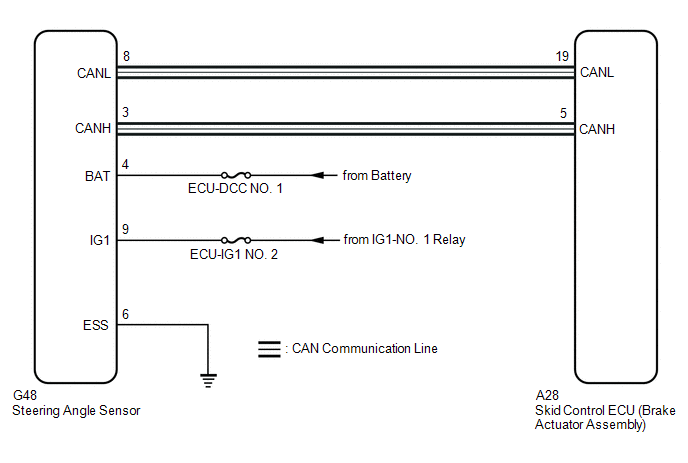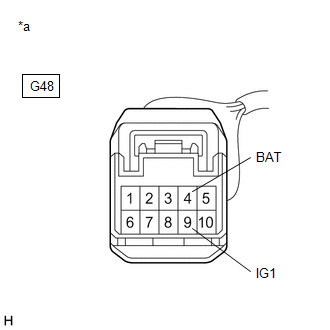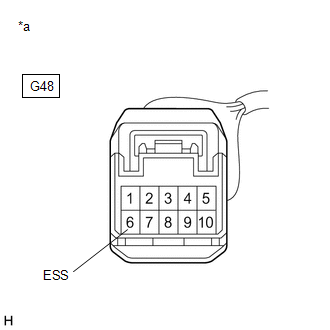Toyota Avalon (XX50): NE Signal Circuit (C1224). SA1 Solenoid Circuit (C1225-C1228,C1468,C1469,C146A,C146B). Steering Angle Sensor Circuit (C1231)
NE Signal Circuit (C1224)
DESCRIPTION
The skid control ECU (brake actuator assembly) receives engine speed signals from the ECM via CAN communication.
|
DTC No. | Detection Item |
DTC Detection Condition | Trouble Area |
|
C1224 | NE Signal Circuit |
The
vehicle speed is 6 km/h (4 mph) or more, the +BS terminal voltage is
between 9.6 and 16.5 V, and the engine speed signal is more than 12800
rpm for 2.5 seconds or more. |
- CAN communication system
- ECM
|
PROCEDURE
| 1. |
CHECK CAN COMMUNICATION SYSTEM |
(a) Check if CAN communication system DTCs are output.
Click here 
|
Result | Proceed to |
|
DTCs are not output | A |
|
DTCs are output | B |
| B |
 | INSPECT CAN COMMUNICATION SYSTEM |
|
A |
 | |
(a) Check if SFI system DTCs are output.
Powertrain > Engine > Trouble Codes
|
Result | Proceed to |
|
DTCs are not output | A |
|
DTCs are output | B |
| A |
 | REPLACE ECM |
| B |
 | INSPECT SFI SYSTEM |
SA1 Solenoid Circuit (C1225-C1228,C1468,C1469,C146A,C146B)
DESCRIPTION
These solenoids
turn on when signals are received from the skid control ECU (brake
actuator assembly) and they control the pressure acting on the wheel
cylinders to control the braking force.
|
DTC No. | Detection Item |
DTC Detection Condition | Trouble Area |
|
C1225 | SA1 Solenoid Circuit |
Solenoid valve signal does not match the check result. |
- Solenoid circuit
- Solenoid valve (brake actuator assembly)
|
| C1226 |
SA2 Solenoid Circuit | Solenoid valve signal does not match the check result. |
- Solenoid circuit
- Solenoid valve (brake actuator assembly)
|
| C1227 |
SA3 Solenoid Circuit | Solenoid valve signal does not match the check result. |
- Solenoid circuit
- Solenoid valve (brake actuator assembly)
|
| C1228 |
STR Solenoid Circuit | Solenoid valve signal does not match the check result. |
- Solenoid circuit
- Solenoid valve (brake actuator assembly)
|
| C1468 |
SFR Solenoid Circuit | Solenoid valve signal does not match the check result. |
- Solenoid circuit
- Solenoid valve (brake actuator assembly)
|
| C1469 |
SFL Solenoid Circuit | Solenoid valve signal does not match the check result. |
- Solenoid circuit
- Solenoid valve (brake actuator assembly)
|
| C146A |
SRR Solenoid Circuit | Solenoid valve signal does not match the check result. |
- Solenoid circuit
- Solenoid valve (brake actuator assembly)
|
| C146B |
SRL Solenoid Circuit | Solenoid valve signal does not match the check result. |
- Solenoid circuit
- Solenoid valve (brake actuator assembly)
|
WIRING DIAGRAM
Refer to DTC C146E.
Click here 
CAUTION / NOTICE / HINT
NOTICE:
When
replacing the skid control ECU (brake actuator assembly), perform
system variant learning and acceleration sensor zero point calibration.
Click here

PROCEDURE
HINT:
These codes are detected when a problem is determined in the skid control ECU (brake actuator assembly).
The solenoid circuits are in the skid control ECU (brake actuator assembly).
Therefore,
solenoid circuit inspection and solenoid unit inspection cannot be
performed. Be sure to check if any DTCs are output before replacing the
skid control ECU (brake actuator assembly).
(a) Clear the DTCs.
Chassis > ABS/VSC/TRAC/EPB > Clear DTCs
(b) Turn the engine switch off.
(c) Start the engine.
(d) Drive the vehicle at a speed of 20 km/h (12 mph) or more.
(e) Check if the same DTC is output.
Chassis > ABS/VSC/TRAC/EPB > Trouble Codes
|
Result | Proceed to |
|
Both C1225, C1226, C1227, C1228, C1468, C1469, C146A and C146B are not output |
A |
| C1225, C1226, C1227, C1228, C1468, C1469, C146A or C146B is output |
B |
HINT:
- The skid control ECU (brake actuator assembly) performs self diagnosis
of the solenoid circuit after the engine switch is turned on (IG).
- If the normal system code is output (no DTCs are output), slightly
jiggle the connectors, wire harness, and fuses of the skid control ECU
(brake actuator assembly).
- If any DTCs are output while jiggling a connector or wire harness of the
skid control ECU (brake actuator assembly), inspect and repair the
connector or wire harness.
- If no DTCs were output when reconfirming DTCs, checking for intermittent
problems is necessary because it is suspected that the original DTCs
were stored due to the poor connection of a connector terminal.
| A |
 | USE SIMULATION METHOD TO CHECK |
| B |
 | REPLACE BRAKE ACTUATOR ASSEMBLY |
Steering Angle Sensor Circuit (C1231)
DESCRIPTION
The skid
control ECU (brake actuator assembly) receives steering angle sensor
signals via CAN communication. When a malfunction occurs in the
communication line with the steering angle sensor, DTC U0126 (Lost
Communication With Steering Angle Sensor Module) is stored.
|
DTC No. | Detection Item |
DTC Detection Condition | Trouble Area |
|
C1231 | Steering Angle Sensor Circuit |
While
steering angle sensor communication is enabled, a malfunction signal
output is received during the sensor self check (sensor malfunction). |
Steering angle sensor internal malfunction |
WIRING DIAGRAM

CAUTION / NOTICE / HINT
NOTICE:
Inspect the fuses for circuits related to this system before performing the following procedure.
HINT:
- When U0126 is output together with C1231, inspect and repair the trouble areas indicated by U0126 first.
Click here 
- When a speed sensor or yaw rate and acceleration sensor (airbag sensor
assembly) is malfunctioning, DTCs for the steering angle sensor may be
output even when the steering angle sensor is normal. When DTCs for a
speed sensor or the yaw rate and acceleration sensor (airbag sensor
assembly) are output together with DTCs for the steering angle sensor,
inspect and repair the speed sensor and yaw rate and acceleration sensor
(airbag sensor assembly) first, and then inspect and repair the
steering angle sensor.
PROCEDURE
(a) Clear the DTCs.
Chassis > ABS/VSC/TRAC/EPB > Clear DTCs
(b) Turn the engine switch off.
(c) Turn the engine switch on (IG) again and check that no CAN communication system DTCs are output.
Click here 
(d)
Drive the vehicle at a speed of 35 km/h (22 mph), turn the steering
wheel to the right and left, and check that no speed sensor and/or yaw
rate and acceleration sensor DTCs are output.
Chassis > ABS/VSC/TRAC/EPB > Trouble Codes
| Result |
Proceed to |
| C1231 is output |
A |
| CAN communication system DTCs are output |
B |
| Speed sensor and/or yaw rate and acceleration sensor DTCs are output |
C |
| C1231 is not output |
D |
HINT:
- When CAN communication system DTCs are output, repair the CAN communication system before repairing each corresponding sensor.
- If there is a malfunction in a speed sensor or the yaw rate and
acceleration sensor (airbag sensor assembly), an abnormal value may be
output even though the steering angle sensor is normal.
- If speed sensor and yaw rate and acceleration sensor DTCs are output
simultaneously, repair the sensors and inspect the steering angle
sensor.
| B |
 | INSPECT CAN COMMUNICATION SYSTEM |
| C |
 | REPAIR CIRCUITS INDICATED BY OUTPUT DTCS |
| D |
 | USE SIMULATION METHOD TO CHECK |
|
A |
 | |
| 2. |
CHECK HARNESS AND CONNECTOR (POWER SOURCE TERMINAL) |
| (a) Turn the engine switch off. |
 |
|
*a | Front view of wire harness connector
(to Steering Angle Sensor) | | |
(b) Remove the steering wheel and column cover.
(c) Make sure that there is no looseness at the locking part and the connecting part of the connector.
OK:
The connector is securely connected.
(d) Disconnect the G48 steering angle sensor connector.
(e) Check both the connector case and the terminals for deformation and corrosion.
OK:
No deformation or corrosion.
(f) Measure the voltage according to the value(s) in the table below.
Standard Voltage:
|
Tester Connection | Condition |
Specified Condition |
|
G48-9 (IG1) - Body ground |
Engine switch on (IG) |
11 to 14 V |
|
G48-4 (BAT) - Body ground |
Always | 11 to 14 V |
| NG |
 | REPAIR OR REPLACE HARNESS OR CONNECTOR (POWER SOURCE CIRCUIT) |
|
OK |
 | |
| 3. |
CHECK HARNESS AND CONNECTOR (GROUND TERMINAL) |
| (a) Turn the engine switch off. |
 |
|
*a | Front view of wire harness connector
(to Steering Angle Sensor) | | |
(b) Measure the resistance according to the value(s) in the table below.
NOTICE:
Before
measuring the resistance of the steering angle sensor, turn the engine
switch off and leave the vehicle for 1 minute or more without operating
the key or switches, or opening or closing the doors.
Standard Resistance:
|
Tester Connection | Condition |
Specified Condition |
|
G48-6 (ESS) - Body ground |
1 minute after engine switch off |
Below 1 О© |
| OK |
 | REPLACE STEERING ANGLE SENSOR |
| NG |
 | REPAIR OR REPLACE HARNESS OR CONNECTOR (GROUND CIRCUIT) |





















